Object Record
Images


Metadata
Catalog number |
P135 |
Artist |
Raimondi, Marcantonio |
Title |
The Three Graces |
Object Name |
Engraving |
Description |
Marcantonio Raimondi, goldsmith and painter, was the most admired printer of his day and this is an example of his fully-developed style. He relied less on contour modeling than fine cross-hatching to model the figures. The women's bodies are rounded, three-dimensional, and sculptural without appearing muscle-bound. They are placed in a space with depth: the central figure's foot just breaks the picture plane, as if it were coming over the edge of the step, subtly enhancing the sense of real space. The image creates an elegant combination of movement and detail. We feel the gentle sway of the Graces as they are joined in contemplating and sharing the fruits they hold, while Raimondi's deft use of fine line produces their intricate hairstyles and the swaying palm leaves above. This classical image and its meaning are typical of the Renaissance. The Three Graces, daughters of Zeus and the nymph Eurynome, represented Joy, Charm and Beauty, ideals that were central to Neo-Platonic discussions as they are today-love being a timelessly popular subject. They are often associated with the god and goddess of love, Venus and Cupid (or Aphrodite and Eros). Raimondi produced some 1,000 prints, the majority of them from designs by the painter Raphael. Their highly successful partnership, an early example of collaboration between a designing artist and a reproduction printer, is an example of a modern form of production we can trace back to the Renaissance. Skill and subject matter put Raimondi's work in high demand across Italy and throughout northern Europe. Artists would copy these prints to learn how to model drapery, gestures, and the figure. His style was clear and his modeling of figures unobtrusive, qualities that lend themselves to teaching, without the artist overpowering the student's own developing style. Teresa Clarkson-Farrell, in "SCHOLARS, EXPLORERS, PRIESTS, How the Renaissance Gave Us the Modern World," ex. cat. G -T M, Queens College, CUNY, February 2 - March 27, 2010, 71. |
Medium/Material |
Ink on paper |
Dimensions |
H-8 W-14.3 inches |
Year Range from |
1500 |
Year Range to |
1515 |
Search Terms |
Renaissance 15th century AD 16th century AD Mythological Greek and Roman Figure Deity Sexuality Italy Europe |
Exhibition and Publication History |
* "SCHOLARS, EXPLORERS, PRIESTS, How the Renaissance Gave Us the Modern World," Curated by James M. Saslow, G -T M, Queens College, CUNY, February 2 - March 27, 2010, # 71, ill. *Exhibited in 'Hope is the Thing with Feathers: Art of the Natural World', 4/11-7/31/2019. |
Culture |
Italian |

